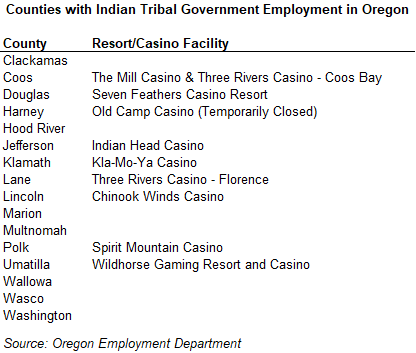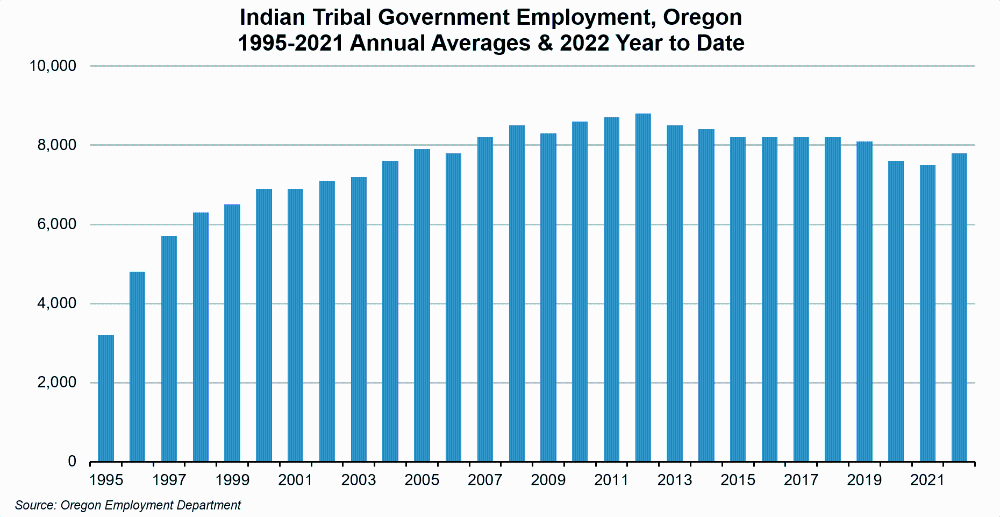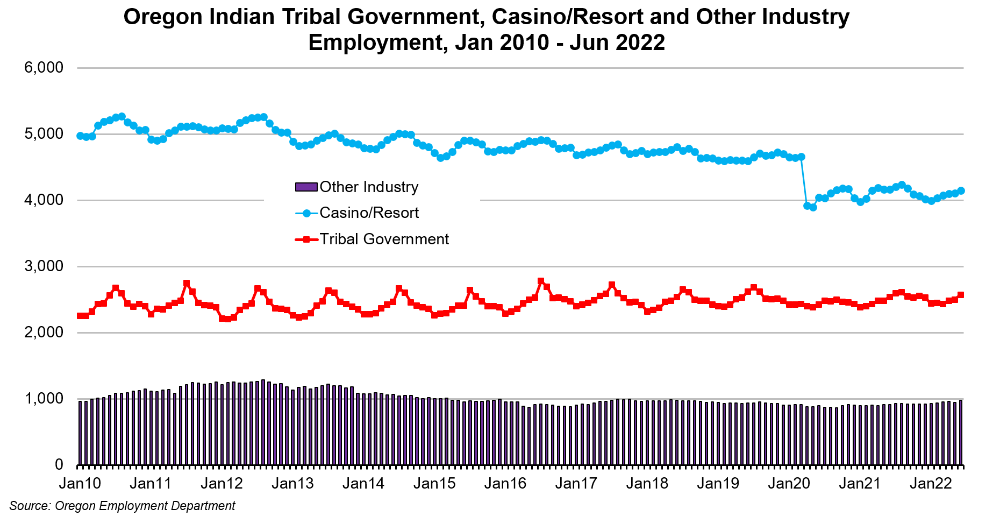Oregon Indian Tribal Gaming and Employment
December 15, 2022In 1987, the U.S. Supreme Court affirmed the authority of tribal governments to establish gaming operations independent of state regulation, provided that the state in question permits some form of gaming. Congress took up the issue of tribal gaming and conducted a series of hearings, ultimately culminating in the passage of the Indian Gaming Regulatory Act of 1988 (IGRA).
The National Indian Gaming Commission (NIGC) – www.nigc.gov – is an independent federal regulatory agency of the United States that was established pursuant to the IGRA. The NIGC website provides a list of gaming tribes and reports on tribal gaming revenue. In 2021, the most recent year on record, the NIGC estimates that there were 510 Indian gaming establishments in the United States associated with 243 tribes across 29 states. According to the NIGC, there were eight Indian casinos operating in Oregon during the same period.
Nationally, the Indian gaming industry has grown substantially in the last 25 years. Total revenue rose from $5.5 billion in fiscal year (FY) 1995, to a record $39 billion in 2021. Gaming revenue in 2021 increased by 40% over the pandemic level in 2020, and 13% above 2019’s revenue total.
California and Northern Nevada alone generated $11.9 billion in FY 2021, with 78 Indian gaming operations reporting gaming revenues. In the Portland region, which includes Alaska, Idaho, Oregon, and Washington, Indian tribes operated 56 gaming facilities and generated $4.4 billion in 2021. Nationally, there were 43 tribal gaming operations with revenues of $250 million or more in 2021. Although these operations account for just 8% of the total number of gaming operations, they generated 52% of Indian gaming revenue in 2021.
The contributions of Indian gaming to Oregon’s economy were analyzed by ECONorthwest over 2018 and 2019. According to the report, Indian tribal gaming stimulated more than $1.61 billion in total economic output statewide, supporting 5,206 direct jobs and $282.3 million in wages and benefits. Indirect and induced impacts (business to business transactions) produced an additional 5,667 jobs along with $273.7 million in wages and benefits. Grants and donations from Indian tribes to local charities totaled $8.0 million in 2019.
Indian Gaming Facilities in Oregon
Each of Oregon’s nine federally recognized tribes have operated a casino. The Cow Creek Band of Umpqua Indians was the first, opening Cow Creek Indian Bingo in 1992, which was quickly expanded into Seven Feathers Casino. Five additional casinos were operating by the end of 1995:
- Wildhorse – Confederated Tribes of Umatilla
- Chinook Winds – Confederated Tribes of Siletz
- Indian Head – Confederated Tribes of Warm Springs
- The Mill – Coquille Indian Tribe
- Spirit Mountain – Confederated Tribes of the Grand Ronde
Kla-Mo-Ya Casino – operated by the Klamath Tribes – opened in 1997, followed by Old Camp Casino – operated by the Burns Paiute Tribe – in 1998. The Old Camp Casino closed in late 2012. Plans for a new facility were announced but have yet to materialize. Indian Head Casino changed its name to Kah-Nee-Ta High Desert Resort & Casino in February of 2001, but a new, expanded facility opened in 2012, reverting back to the Indian Head Casino title. Three Rivers Casino – operated by the Confederated Tribes of Coos, Lower Umpqua and Siuslaw – opened in 2004. An additional gaming facility, Three Rivers Casino-Coos Bay, opened in May 2015.

In addition to the nine operating casino locations (Three Rivers Casino has two locations), Oregon’s Indian tribal government employment is spread out across 16 counties. Despite the high concentration of jobs in casino gaming, many other industries and activities provide Indian tribal government employment.
Oregon’s Indian Tribal Employment Profile
The current Indian tribal government employment series dates back to 1995 when it was reclassified under local government ownership (previously, it was considered private ownership). In its first year, Indian tribal government had an average of3,200 jobs. Although a comparative employment figure for 1994 isn’t available, Indian tribal government entered 1995 with just 2,200 jobs and by December its total reached 4,200, a gain of 2,000 jobs.
Indian tribal government averaged 6,300 workers in 1998, a gain of 3,100 or nearly 100% over its 1995 average. And the industry continued to grow, adding 2,500 jobs to average 8,800 in 2012, an increase of nearly 40%.

Beginning in 2013, however, Indian tribal government pulled back, falling to 8,200 jobs in 2015 and holding steady from 2016 to 2018. COVID-19 job losses hit Indian tribal government in 2020, dropping its employment total to 7,600, its lowest level since 2006. Payrolls also fell in 2020 – by about 2.3% or $8.1 million – but the average wage actually rose to $45,123, an increase of 4.9%.
Due to the continued impact of the pandemic, employment in Indian tribal government decreased to 7,500 jobs in 2021, but payrolls rose by $54 million or 15.9% to total $394.2 million. Wages rose by $7,162 (15.9%) in 2021 to average $52,285. Over the year ending in October 2022, Indian tribal government regained 700 jobs to reach 8,200, its highest October employment level since 2014’s 8,300.
Indian tribal governments in Oregon operated 86 employer units in 2021, covering the 16 counties shown in the table. Public administration, which typically represents government administrative functions, provided 32% of the industry’s jobs.

Outside government administrative work and resort and casino employment, about 12% of Indian tribal government jobs were found in industries that include agriculture, utilities, construction, manufacturing, retail trade, information, financial activities, professional and business services, educational and health services, and other services. The amusement, gambling and recreation sector and casino hotels (resort and casino) held close to 55% of Oregon’s 2021 Indian tribal government employment.